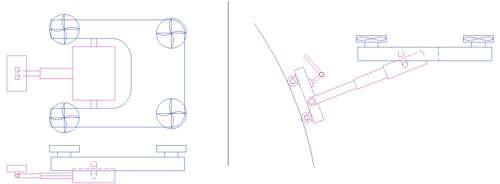 Recently I have come across the development of a robotic device called BladeBug. It is a legged moving robot for maintenance work on wind turbine blades, specifically for offshore turbines. Suction caps stick to a body for which the robot is to do some work. Congratulations to the people involved in developing the device. There are a lot of challenges to overcome for any new development to achieve the expected capabilities.
Recently I have come across the development of a robotic device called BladeBug. It is a legged moving robot for maintenance work on wind turbine blades, specifically for offshore turbines. Suction caps stick to a body for which the robot is to do some work. Congratulations to the people involved in developing the device. There are a lot of challenges to overcome for any new development to achieve the expected capabilities.By Ahmad Hemami, McGill University, Montreal, Canada
I started similar work 20 years ago to develop a climbing robot, with application in the aerospace industry in mind. The idea was to develop a mobile platform capable of climbing on the surfaces of an aircraft to primarily check the condition of the rivets via an automated process through its robotic arm. The process is a repetitive action to be performed on each rivet: cleaning the surface, applying a penetrating oil and checking for possible cracks by taking a picture which would be saved in a databank as a record.
In the process of securing funds for the project from the aerospace companies, suddenly the September 11 incident occurred, which was a huge disruption; it took several years for the airline companies to return to their previous state. Although the aerospace companies are thought to have not reached the described level of maintenance, we see that other industries (wind turbines) can also benefit from such a capability.
 Today, even if I had the money available to me, I would not follow the same idea (climbing robot) because of the advancements in the technology. A mobile robot that needs to stick to a body, no matter whether moving on wheels or legs, needs a vacuum machine (or a compressor) to provide the necessary suction. If this suction is to come from an external source, then the weight and the physical limitation associated with a hose bringing the suction to the point is a big burden. Imagine a blade that can be 50 to 60 metres long in the middle of the air.
Today, even if I had the money available to me, I would not follow the same idea (climbing robot) because of the advancements in the technology. A mobile robot that needs to stick to a body, no matter whether moving on wheels or legs, needs a vacuum machine (or a compressor) to provide the necessary suction. If this suction is to come from an external source, then the weight and the physical limitation associated with a hose bringing the suction to the point is a big burden. Imagine a blade that can be 50 to 60 metres long in the middle of the air.In recent years, drone technology has progressed remarkably. This means that its technology has proved itself, and it is not in its infancy. At the present time, drones can be used for remotely taking pictures that could be used for visual inspection. By remotely, I mean without landing.
The next generation of drones will be capable of working on a remote item, either with or without landing. Landing on a surface and sticking to it (for the maintenance work) for the duration of the work, must necessarily be through suction caps. This necessary suction will be provided by an on-board machine. It is worth mentioning, also, the progress that has been made in batteries and their improvements over the older technology in the past 20 years, which has already contributed to various success stories.
This does not imply that the endeavour is free of challenges. There are still many technical challenges which need to be overcome for such a target to be reached. Indeed, the big challenge lies ahead.
Undoubtedly, for wind turbines in remote and harsh conditions this is the way to go, and this is just the beginning. Some players may have already started working on this concept. Surely, if not on the agenda yet, it will be later.
Further Reading
https://bladebug.co.uk/
https://www.windtech-international.com/product-news/autonomous-motherships-and-robot-repair-teams-for-offshore-wind-farms
https://bladebug.co.uk/
https://www.windtech-international.com/product-news/autonomous-motherships-and-robot-repair-teams-for-offshore-wind-farms








